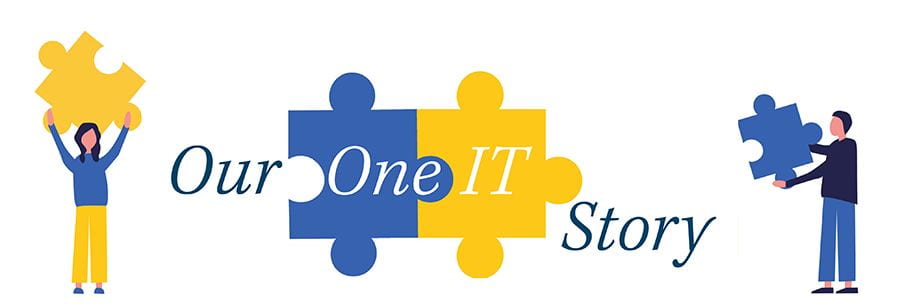
Our One IT Story
Since Raymond Lefebvre began his tenure at UMass Boston as Chief Information Officer, he has identified an annual theme or goal that IT will aspire to in the upcoming calendar year. In 2021, IT pursued “unITy” by bringing the UMass Boston community together again on campus after the disruptions caused by the 2020 pandemic. In 2022, the focus was on “simplicITy,” as the department sought to streamline and simplify the ways in which the university uses IT, and so benefit from IT even more. In 2023, IT strengthened and unified how IT is used throughout the university by bringing all IT professionals at UMass Boston together under the banner of “One IT.”
However, when “One IT” was initially introduced in an email on January 3, 2023 there was not a full understanding of what its objectives were. The message said that in 2023, IT will be “focused on aligning with and embracing our IT partners with the goal of becoming as effective and efficient as possible at delivering and supporting IT services at UMass Boston,” but some people didn’t know who the “partners” they were supposed to be “aligning with and embracing” were. What everyone in IT who did not already know soon learned is that there are dozens of UMass Boston employees across campus who support information technology but are not in the IT department. As Ray describes, “There are other IT professionals amongst us that don’t work for IT.” He estimated there are about forty+ of what he called “embedded IT personnel” employed in other departments and colleges throughout the university.
Yet while that explains who the IT partners are, it did not say why that was an issue that needed addressing. To answer that, Ray pointed to the effect it has had on IT’s institutional culture. Over the years, probably so gradually and subtlety those involved were not even aware it was happening, the relationship between the IT department and IT workers outside the department was withering. “Adversarial” is not the right word to describe it, but neither is “cooperative.” At best, an indifference developed. Neither side felt supported by the other nor thought their work was relevant to the other. There definitely was not the sense they were working together to make information technology as large an asset to UMass Boston as possible, and as that is one of CIO Lefebvre’s chief objectives, he knew action needed to be taken.
Ray said that under some types of leadership the approach would be to get all those supporting IT outside the IT department to work in IT, but he thought in this case that would be counterproductive. He believes that these employees are “well positioned where they are. Where their boots are on the ground is right where they need to be, and they provide IT value.” So instead, under the “One IT” banner, the “IT Partners” program was launched. Ray added, “I have met with forty plus UMass Boston IT professionals within their own business units to establish working relationships, and now I meet with them quarterly to understand who they are. I ask them what do they do in support of technology at UMass Boston? How can we help them? How can we be one?” Other measures have been taken as part of this initiative. Not only are the “IT Partners” invited to the IT department’s quarterly meetings they are also invited to the seasonal social events, such as the summer barbeque that takes place out on the lawn. Anything that Ray could think of to make the partners feel more connected and important was put in place, and the results have been extraordinary.
One measure that was recently taken may be more symbolic than substantive, but it has been very validating to the partners and really makes them feel that they are a part of IT. In September, the new IT organizational chart was released, and included in it for the first time, under the heading of IT Partners, are the names of the many IT professionals embedded in colleges/departments along with their job titles and departments they work in. As you can imagine, seeing your name and professional identity on an organizational flow chart under the heading “Information Technology Services” will do a lot to make you feel like you are a member of the team.
Thanks to “One IT” and the “IT Partners” program, IT has strengthened its presence and importance to UMass Boston making IT an even greater asset to the university in the future.